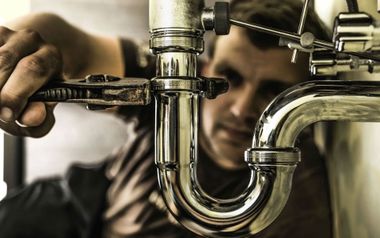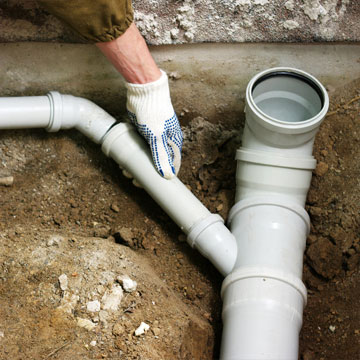The Core Parts of Your Home's Plumbing System
The Core Parts of Your Home's Plumbing System
Blog Article
This article down the page in relation to Plumbing Installation 101: All You Need to Know is absolutely intriguing. Try it and make your own conclusions.

Comprehending how your home's pipes system functions is vital for every home owner. From providing tidy water for drinking, food preparation, and bathing to safely eliminating wastewater, a properly maintained plumbing system is vital for your family members's health and wellness and comfort. In this detailed overview, we'll discover the intricate network that comprises your home's pipes and offer suggestions on upkeep, upgrades, and taking care of common concerns.
Introduction
Your home's pipes system is more than just a network of pipelines; it's a complicated system that ensures you have accessibility to clean water and reliable wastewater removal. Recognizing its parts and how they collaborate can aid you stop costly fixings and make certain everything runs efficiently.
Basic Components of a Plumbing System
Pipelines and Tubes
At the heart of your pipes system are the pipelines and tubes that bring water throughout your home. These can be made from different materials such as copper, PVC, or PEX, each with its benefits in terms of sturdiness and cost-effectiveness.
Fixtures: Sinks, Toilets, Showers, and so on.
Components like sinks, commodes, showers, and bathtubs are where water is utilized in your house. Understanding just how these fixtures link to the plumbing system assists in detecting problems and planning upgrades.
Valves and Shut-off Points
Shutoffs regulate the flow of water in your pipes system. Shut-off valves are essential throughout emergencies or when you need to make repairs, allowing you to separate parts of the system without interfering with water flow to the entire home.
Water System System
Main Water Line
The main water line connects your home to the community water or a private well. It's where water enters your home and is dispersed to numerous components.
Water Meter and Stress Regulator
The water meter steps your water usage, while a pressure regulator ensures that water streams at a risk-free pressure throughout your home's plumbing system, avoiding damage to pipelines and components.
Cold Water vs. Hot Water Lines
Understanding the difference in between cold water lines, which supply water directly from the major, and warm water lines, which lug warmed water from the water heater, helps in troubleshooting and preparing for upgrades.
Water drainage System
Drain Pipes Water Lines and Traps
Drain pipes carry wastewater away from sinks, showers, and toilets to the sewage system or septic system. Traps stop drain gases from entering your home and additionally trap particles that could trigger clogs.
Air flow Pipes
Air flow pipes enable air right into the drain system, stopping suction that could slow down water drainage and cause traps to empty. Proper ventilation is vital for keeping the stability of your pipes system.
Importance of Appropriate Water Drainage
Making sure proper water drainage protects against backups and water damages. Regularly cleansing drains pipes and preserving catches can avoid expensive fixings and prolong the life of your pipes system.
Water Heater
Sorts Of Water Heaters
Water heaters can be tankless or traditional tank-style. Tankless heaters warmth water as needed, while tanks save warmed water for instant usage.
Upgrading Your Plumbing System
Factors for Upgrading
Upgrading to water-efficient components or replacing old pipelines can improve water quality, lower water bills, and boost the value of your home.
Modern Plumbing Technologies and Their Advantages
Explore modern technologies like clever leak detectors, water-saving bathrooms, and energy-efficient hot water heater that can save cash and reduce environmental effect.
Price Considerations and ROI
Calculate the upfront expenses versus lasting financial savings when considering pipes upgrades. Several upgrades spend for themselves through minimized energy costs and fewer repair work.
How Water Heaters Connect to the Plumbing System
Comprehending just how hot water heater attach to both the cold water supply and hot water distribution lines assists in detecting concerns like not enough hot water or leaks.
Upkeep Tips for Water Heaters
Regularly purging your hot water heater to remove sediment, examining the temperature level settings, and examining for leaks can prolong its life expectancy and boost power performance.
Usual Pipes Concerns
Leaks and Their Reasons
Leakages can occur because of maturing pipelines, loose fittings, or high water pressure. Dealing with leaks promptly avoids water damage and mold development.
Obstructions and Blockages
Clogs in drains and toilets are often caused by flushing non-flushable things or a build-up of oil and hair. Making use of drain displays and bearing in mind what drops your drains pipes can stop obstructions.
Indicators of Plumbing Issues to Look For
Low tide stress, slow-moving drains, foul odors, or unusually high water costs are indicators of possible plumbing problems that must be attended to promptly.
Pipes Upkeep Tips
Regular Examinations and Checks
Schedule annual plumbing inspections to capture problems early. Try to find indicators of leakages, deterioration, or mineral build-up in taps and showerheads.
Do It Yourself Upkeep Tasks
Straightforward jobs like cleaning faucet aerators, looking for commode leakages making use of dye tablets, or protecting subjected pipelines in cool environments can avoid major plumbing problems.
When to Call a Specialist Plumbing Professional
Know when a pipes issue requires expert know-how. Trying intricate repair services without appropriate expertise can cause even more damages and greater fixing prices.
Tips for Lowering Water Use
Easy routines like taking care of leakages immediately, taking much shorter showers, and running complete tons of laundry and recipes can preserve water and reduced your energy costs.
Eco-Friendly Pipes Options
Take into consideration lasting pipes products like bamboo for floor covering, which is durable and green, or recycled glass for counter tops.
Emergency Preparedness
Steps to Take During a Plumbing Emergency situation
Know where your shut-off shutoffs lie and exactly how to turn off the water supply in case of a burst pipeline or significant leakage.
Value of Having Emergency Situation Get In Touches With Helpful
Keep call info for regional plumbing professionals or emergency situation solutions easily available for quick action during a plumbing crisis.
Ecological Impact and Conservation
Water-Saving Fixtures and Devices
Installing low-flow faucets, showerheads, and toilets can significantly decrease water usage without giving up efficiency.
Do It Yourself Emergency Situation Fixes (When Relevant).
Short-term fixes like making use of air duct tape to patch a leaking pipeline or placing a pail under a leaking tap can reduce damage till an expert plumber shows up.
Conclusion.
Recognizing the composition of your home's plumbing system encourages you to keep it effectively, saving time and money on fixings. By following normal maintenance regimens and staying educated about modern pipes technologies, you can guarantee your plumbing system runs efficiently for several years to come.
The Anatomy of Your Home s Plumbing System
Understanding the anatomy of your home s plumbing system is essential for any homeowner. It not only helps in identifying potential issues but also facilitates effective communication with professionals when repairs or upgrades are needed. Your home s plumbing system is more than just pipes and faucets; it s a complex network that ensures the efficient and hygienic flow of water in and out of your house. In this blog, we ll dissect the crucial components of your home s plumbing system. For those in Antelope Valley, Brock Plumbing is your trusted partner for all your plumbing needs, ensuring your system functions smoothly and efficiently.
Water Supply System
Main Water Line: This is where your home s plumbing system begins. The main water line connects your home to the public water supply or a private well. Pipes and Shut-off Valves: Pipes distribute water throughout your home. Shut-off valves are crucial for controlling the flow of water and making repairs without shutting off the entire system. Drainage System
Drain Pipes: These pipes carry waste and water away from sinks, toilets, and showers. Vents: Vents allow sewer gases to escape and help maintain proper pressure in the drainage pipes, ensuring efficient flow of wastewater. Traps: Every fixture has a trap, a U-shaped pipe that holds water and prevents sewer gases from entering your home. The most common is the P-trap under sinks. Fixtures and Appliances
Fixtures and appliances are the most interacted with parts of your plumbing system. They include sinks, toilets, showers, dishwashers, and washing machines. Each fixture and appliance has its own supply and drainage connection, ensuring they receive clean water and can dispose of wastewater effectively.
Water Heating System
Your water heater is a crucial component, providing hot water to various fixtures and appliances in your home. It can be tank-based or tankless, with each type having its own set of advantages and maintenance requirements. Regular maintenance is essential to ensure efficient operation and extend the lifespan of the unit.
Sump Pump
In areas prone to flooding or with high water tables, a sump pump is an essential part of the plumbing system. It s installed in the lowest part of your basement or crawlspace and pumps out water that accumulates, preventing flooding and protecting your home from water damage.
Septic System
Homes that are not connected to a municipal sewer system have a septic system and an underground wastewater treatment structure. Understanding how to maintain your septic system is crucial to prevent backups, odors, and early system failure.
Conclusion
Your home s plumbing system is a complex and essential network, ensuring the efficient and hygienic flow of water in and out of your property. Understanding its key components helps in maintaining it properly and identifying issues before they escalate into major problems. For residents in Antelope Valley, Brock Plumbing is dedicated to providing top-notch services, ensuring that every part of your plumbing system is in perfect working order. Trust our team of professionals to handle all your plumbing needs, ensuring your home remains comfortable, safe, and well-maintained.
https://brockplumbinganddrains.com/blog/the-anatomy-of-your-homes-plumbing-system/

Hopefully you liked our post on Exploring Your Homes Plumbing Anatomy. Thanks a ton for taking a few minutes to browse our article. Loved our blog entry? Please share it. Help others locate it. I praise you for being here. Kindly come by our website back soon.
Click On This Link Report this page